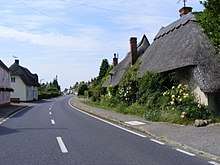The Rodings
The Rodings (or Roothings) are a group of eight villages in the upper part of the River Roding and the west of Essex, England, the largest group in the country to bear a common name.[1] The typical pronunciation of the name is "Roadings".

History
The Rodings are believed to be the remnants of a single Anglo-Saxon community known as the Hroðingas, led by Hroða, who sailed up the River Thames and along a tributary in the sixth century and settled in the area.[1] This was one of the tribal areas that were absorbed into the Kingdom of Essex.[2] The River Roding and the villages derived their name from Hroða.[1]
The villages are recorded in the Domesday Book of 1086 as Rodinges in the Hundred of Dunmow.[3] In the time of Edward the Confessor, it was held by the Abbey of St Æthelthryth of Ely; however, after the Norman Conquest, part was taken by William de Warenne.[3] Part was also held by the de Veres and de Mandevilles families, who became the Earls of Oxford and Earls of Essex.[1] By the 14th century, the boundaries and names of the villages had become fairly established.[1] Abbess, Beauchamp and Berners Roding now form a single parish in the district of Epping Forest.
In the second half of the 19th century The Rodings came part of the Dunmow and Ongar Unions – poor relief provision set up under the Poor Law Amendment Act 1834. The parishes were in the rural deaneries of Roding and Ongar, the Archdeaconry of Essex, and the Diocese of St Albans. In 1914 the parishes came under the Diocese of Chelmsford. There were occasionally found Roman remains in the area. Crops grown at the time were chiefly wheat, barley and beans, on a heavy soil with a clay subsoil.[4]
Governance
An electoral ward in the same name exists. The population of this ward at the 2011 Census was 1,853.[5]
Landmarks
The area is typified by medieval thatched cottages, timber-framed manor houses and farmhouses. There is a mid-18th century post mill windmill in Aythorpe Roding, the only surviving windmill in the area. There are a number of churches dating from the Norman period; the oldest is St Margaret of Antioch in Margaret Roding, which has a Norman doorway and the tomb of a crusader.[1]
Roding names
The Rodings do not lie within a single district in the county; they are arranged around the tripoint of the administrative areas of Chelmsford, Uttlesford and Epping Forest.
- Abbess Roding
- Aythorpe Roding
- Beauchamp Roding (pronounced Beecham Roding)
- Berners Roding
- High Roding
- Leaden Roding
- Margaret Roding
- White Roding
- Morell Roding (previously centred on Cammas Hall, the hamlet was absorbed by White Roding; today nonexistent although a defined area of land[4][6][7])
Transport links
A single bus service, number 59, serves White Roding, Leaden Roding and Margaret Roding. It is operated by Arriva Shires & Essex, running hourly in each direction to Harlow via Hatfield Heath and Chelmsford via Roxwell. The route is on the Hertfordshire Intalink network.
Ecclesiastical organisation
In the Church of England Diocese of Chelmsford, Leaden, Abbess, White and Beauchamp Roding have formed the South Rodings parish since 2004.[8] High and Aythorpe Roding are beneficed to Great Canfield and Margaret Roding to Good and High Easter, those 6 parishes are served by one priest-in-charge. Berners Roding is now part of the Parish of Willingale, the Parish Church of unknown dedication (but thought to be All Saints) is redundant and is privately owned.[9]
See also
Further reading
- Stephen Basset, Stephen (1997), "Continuity and fission in the Anglo-Saxon landscape: the origins of the Rodings (Essex)", in Landscape History, vol 19: pp. 25–42[10]
References
- Rollason, Pam (June 2008). "Around the Rodings". Essex Life. Archant. p. 92. Retrieved 2009-02-03. (Registration required.)
- Andrew Reynolds, Later Anglo-Saxon England (Tempus, 2002, page 67) drawing on S Bassett (ed) The Origin of Anglo-Saxon Kingdoms (Leicester, 1989)
- Dr Ann Williams; Professor G H Martin, ed. (2003). Domesday Book: A Complete Translation. London: Penguin Books. pp. 982, 996, 1393. ISBN 978-0-14-143994-5.
- Kelly's Directory of Essex 1882 p.245; 1894 p.285; 1902 p.339; 1914 p.477
- "Ward population 2011". Retrieved 28 September 2015.
- Lewis, Samuel (1831) A topographical dictionary of England, vol 3, p.630
- "Lost In Time: A short History of Morrell Roding", Aythorpe Roding Parish Council. Retrieved 8 February 2018
- South Rodings parish history
- "Berners Roding Parish Church (De-consecrated)", Abbess, Beauchamp & Berners Roding Parish Council. Retrieved 30 January 2018
- Basset, Stephen (1997). "Continuity and fission in the Anglo-Saxon landscape: the origins of the Rodings (Essex)". Landscape History. 19: 25–42.